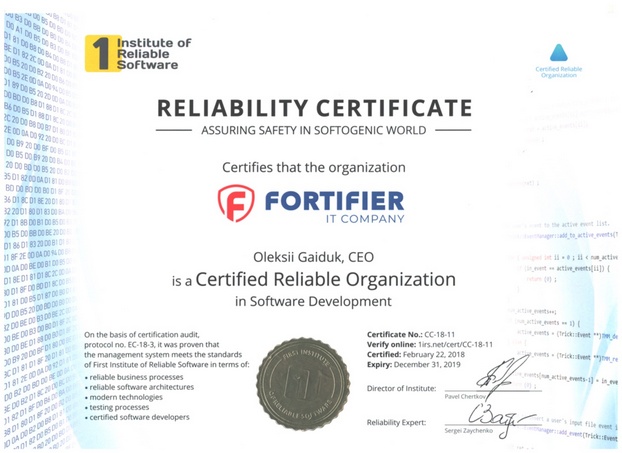
Reliability Certification Memorandum of goals
All of our developers are certified members of the First Institute of the Reliable Software. At Fortifier, we proclaim reliability as the cornerstone value that drives our business relations and software development processes. To us, reliability is an irreplaceable part of our corporate culture and the new worldwide IT industry standard.
What does it mean?
- Analyzing every project’s business goals in detail to determine the most suitable solution
- Verifying the solution’s feasibility thoroughly
- Paying extra attention to our clients’ requirements and wishes
- Creating responsive UI/UX design according to various user scenarios
- Making change requests smooth and managing them with care
- Promoting reliability and personal responsibility within the company
Reliability metrics
Fortifier IT specialists follow the globally recognized EEE 982, IEEE 1091, ISO/IEC 9126 software development standards.
Regarding the circumstances of the project, business needs and customer goals we provide such metrics which allows controlling level of reliability of the software product:
- Fault Density
- Defect Density
- Cumulative Failure Profile
- Functional or Modular Test
- Coverage
- Cause and Effect Graphing
- Requirements Traceability
- Defect Indices
- Error Distribution(s)
- Software Maturity Index
- Number of Conflicting
- Requirements
- Minimal Unit Test Case
- Determination
- Design Structure
- Test Coverage
Values of the Reliability Standard
Stages of Reliable Approach
Step 1 Investigation
Step 2 UI/UX Design
Step 3 Development
Step 4 Quality Assurance
Step 5 Implementation
Security
We ensure the security of our solutions and their data by using a wide spectrum of technologies and methods.
We store the entire code on GitLab, which is a globally trusted product. We design a flexible access policy with different access levels and a variety of roles for every project we work on.
The project’s infrastructure is implemented using trusted products such as AWS, Azure, and GCP. Access to the infrastructure is possible via Virtual Private Networks (VPN). This isolates the infrastructure from any external networks. Developers don’t have direct access to it, and the code is delivered via CI.
Finally, access to particular servers can be gained only via the security protocol. The list of people that can access them is restricted.
